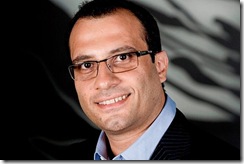In February, Jay Srage was promoted to become president for Qualcomm in the MEA region. In his broadened role he shall focus on strategies that cut across the entire region and believes the three years that Qualcomm has been physically present in the region have been met with huge success 
Jay Srage says that on a wider view, Qualcomm is also a huge supporter of the vision of the ‘Internet of everything’ in which anything that benefits from being connected to a network shall be
The benefits of addressing developments in the telecom space across the entire MEA means that Qualcomm is able to offer a wide range of advisory and support functions to operators, based on its pan-regional conversations and experiences. Jay Srage says it just didn’t make sense to have two different regions to support, and so with a central hub in Dubai, Qualcomm will oversee its interactions across the two continents.
Large markets in Africa, such as South Africa, Nigeria and Kenya are of strategic significance given the role they play in pointing in the direction that other operators on the continent shall follow, and just as in the Middle East region, Qualcomm will continue to focus its efforts around three main areas.
The first is with respect to network operators and their technology roadmaps, with Srage describing Qualcomm’s role in this area as being the “de facto go-to technological partner” to them.
“Qualcomm does not sell any infrastructure equipment, and thus the advice we give is impartial. It is truly technology neutral, and instead is based on looking at ways operators can improve their businesses,” Srage says.
Qualcomm is also helping network operators when it comes to distribution channel strategies and retail. Qualcomm has already done some work in Saudi Arabia where it has advised mobile device wholesalers and retailers with respect to the best handset inventory to stock.
“We are helping open the eyes of the wholesalers and retailers to what products are available, and helping them expand their product portfolio,” Srage says.
The third area in which Qualcomm is directing a lot of effort and resources is in the development of services and the creation of a mobile services ecosystem in the MEA that has a local flavour. Srage says issues such as customisation are important, as well as the embedding of applications in devices.
A number of trends that are occurring in the regional telecom market are likely to drive it forward in the coming months, and include the mobile broadband phenomenon that Srage describes as having been successful.
“Operators such as STC, Du, and Etisalat already have the fat pipe in place, and have been asking themselves what else can they do,” Srage says.
MHealth is another area in which Qualcomm has dedicated significant resources, and which has obvious applications in the region where access to healthcare may be difficult for some members of the community. The technology provider has already worked with Mobily in Saudi Arabia and Mobinil in Egypt, and Srage says the aim is to have a vibrant mHealth industry in a couple of years time.
Speaking late last year, Gilles Fayad, director of business development, VAS, MENA at Qualcomm forecast there would be as many as 400 million wireless sensors used for medical monitoring globally by 2015, with communications networks playing a central role in allowing remote monitoring and diagnosis to take place. He said he believed that the localisation of mHealth is an important facet to the ecosystem’s development, and should be tailored to fit cultures and geographies. 
“Qualcomm is developing devices in partnership with medical care companies and telecom service providers,” Fayad said. “Phones and gateways (which allow an individual to establish a home network) are the instruments driving mHealth at this current point in time,” he added.
The rollout of communications networks to rural areas is occurring in cooperation with government programmes, and Fayad said mHealth services can utilise such infrastructure, with the issue of localisation having been identified in many regions as being crucial.
Qualcomm is helping develop the global wireless health ecosystem, assisting sufferers of ailments to be able to manage their conditions remotely, either via a mobile device or dedicated medical device. One of the first systems Qualcomm developed was a remote monitoring kit that can be utilised by a remote caregiver.
“Wellness and fitness applications are understood and available,” said Fayad. “In terms of monitoring of diseases and ailments, sufferers are often acutely aware of their conditions and go out looking for solutions.”
On a wider view, Qualcomm is also a huge supporter of the vision of the ‘Internet of everything’ in which anything that benefits from being connected to a network shall be.
“Internet is a de facto standard,” Srage says. “How people utilise it is what is subjective,” he adds. Independent analysts forecast that up to 70 per cent of consumer electronic devices are going to be connected in the coming 3-5 years, with offering such as Orange Jordan’s Livebox and MTN’s ‘Internet in a box’ expanding peoples’ access to the Internet all the time.
Commercially, Qualcomm is and continues to be a significant benefactor of the mobile broadband experience given the company’s production of mobile chipsets, its licensing and royalties from the use of radio technologies, and the growing portfolio of services and applications it has under development.
MHealth, augmented reality, and mEductaion are some of the vertical markets Qualcomm is undertaking significant R&D in, while assisting in the growth of successful mobile application stores is another area of interest for the technology provider.
“We are trying to show models that work when it comes to mobile services,” Srage says. “The processing power of our Snapdragon chipset is immense, so the question now is how do you fill this device with services.”





0 comments ↓
There are no comments yet...Kick things off by filling out the form below.
Leave a Comment